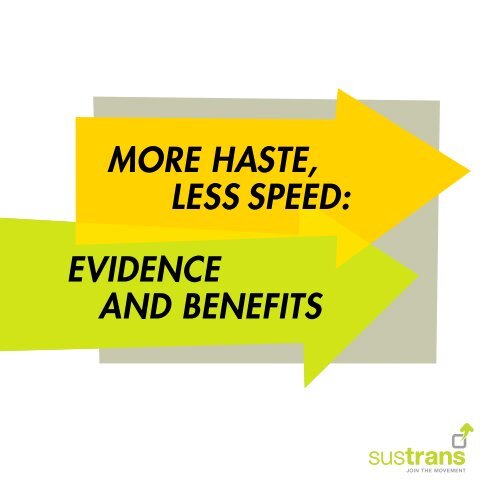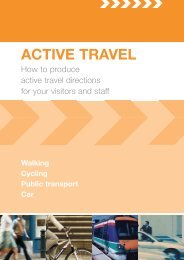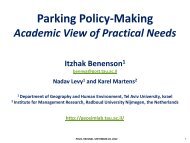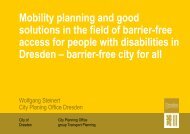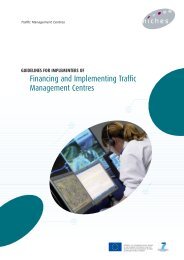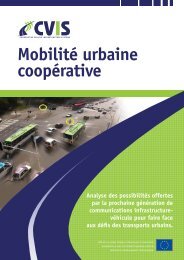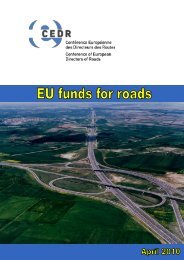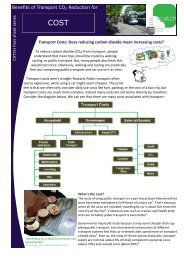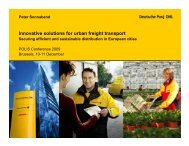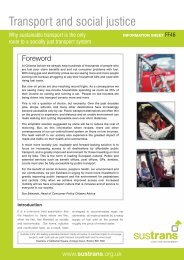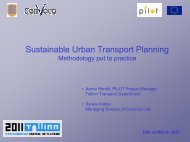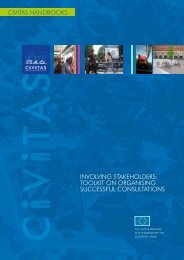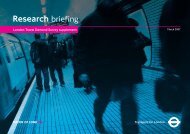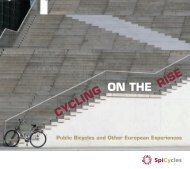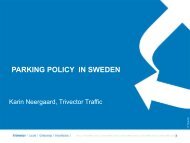More haste, less speed - Evidence and benefits
More haste, less speed - Evidence and benefits
More haste, less speed - Evidence and benefits
Create successful ePaper yourself
Turn your PDF publications into a flip-book with our unique Google optimized e-Paper software.
MORE HASTE,<br />
LESS SPEED:<br />
EVIDENCE<br />
AND BENEFITS
Sustrans’ call to action, MORE HASTE, LESS SPEED,<br />
calls on UK governments to invest in doubling the<br />
number of local journeys under five miles made by<br />
foot, bike <strong>and</strong> public transport to four out of five<br />
by 2020.
<strong>More</strong> Haste, Less Speed identifies twelve actions in five areas that will<br />
bring a major step change towards sustainable travel for local journeys.<br />
This rapid change can be achieved by re-focusing existing transport<br />
budgets <strong>and</strong> thereby reducing the need to spend in other areas that<br />
are influenced by our travel behaviour including health, energy<br />
<strong>and</strong> climate change.<br />
We travel to reach places – work, schools<br />
<strong>and</strong> colleges, shops <strong>and</strong> services, <strong>and</strong> to<br />
visit our friends <strong>and</strong> family. Although these<br />
types of destinations remain the same,<br />
increased car ownership <strong>and</strong> use means<br />
that we are now travelling faster, <strong>and</strong><br />
often further to reach them (1) .<br />
As car use has grown, travel by foot, bike<br />
<strong>and</strong> public transport has declined. Now,<br />
one out of every five journeys under a mile<br />
is made by car, a distance that can easily<br />
be walked. Over two-thirds of journeys<br />
between one <strong>and</strong> five miles are made by<br />
car, a distance that can be cycled or made<br />
by public transport (2) .<br />
The further <strong>and</strong> faster we travel, the <strong>less</strong> we<br />
travel by foot, bike <strong>and</strong> public transport.<br />
Governments have broadly accepted that<br />
the decline in travel by foot, bike <strong>and</strong> public<br />
transport cannot be sustained. A recent<br />
government report highlights research<br />
suggesting that people could replace 78%<br />
of their local car journeys under five miles<br />
with a journey by foot, bike or public<br />
transport (3) . A similar story is told by the<br />
data collected from the Sustainable Travel<br />
Demonstration Towns in Engl<strong>and</strong> (4) .<br />
Sustrans has many years of experience in<br />
enabling people to think <strong>and</strong> act differently<br />
about the journeys they make, <strong>and</strong> to travel<br />
more sustainably.<br />
This document focuses on what Sustrans<br />
has learned from our own <strong>and</strong> others’ work<br />
<strong>and</strong> data about the <strong>benefits</strong> that sustainable<br />
travel brings to us, our health <strong>and</strong> well-being,<br />
our environment <strong>and</strong> our communities.<br />
Using government methodology (5) Sustrans<br />
has demonstrated that investment in<br />
enabling people to choose to walk, cycle<br />
<strong>and</strong> use public transport for local journeys<br />
represents better value for money <strong>and</strong><br />
return on investment than encouraging<br />
more car use.<br />
We can up the pace <strong>and</strong> make real <strong>haste</strong><br />
towards more sustainable local travel<br />
by 2020. To achieve this, governments<br />
will need to accept that travelling far<br />
<strong>and</strong> fast <strong>and</strong> travelling sustainably are<br />
not compatible.
Encourage people to change their<br />
travel behaviour<br />
It is a widely held belief that achieving behaviour<br />
change, particularly in relation to travel, is difficult.<br />
The evidence does not support this. Research carried<br />
out in the three English Sustainable Travel Demonstration<br />
Towns in 2004 revealed a potential for 9 out of 10<br />
journeys to be made by foot, bike <strong>and</strong> public transport (6) .<br />
Following extensive travel behavior change programmes<br />
focussed mainly on households, schools <strong>and</strong> workplaces,<br />
the three towns saw reductions in car use of between 7%<br />
<strong>and</strong> 9% (4) . With further targeted investment in walking<br />
<strong>and</strong> cycling facilities, improvements to local public<br />
transport <strong>and</strong> better l<strong>and</strong>-use planning, the data suggests<br />
that an even greater shift towards sustainable travel<br />
could be achieved.<br />
Sustrans has pioneered some of the most successful travel<br />
behaviour change work in the UK, focusing on changing<br />
everyday local journeys (that make up the majority of<br />
car trips) to journeys by foot, bike <strong>and</strong> public transport.<br />
Our work has focused on two areas: everyday journeys<br />
from home <strong>and</strong> the school journey.<br />
Sustrans has worked with 250,000 households to deliver<br />
TravelSmart, a very successful marketing programme<br />
giving people the information they need to walk, cycle<br />
<strong>and</strong> use public transport more often. We have also<br />
worked with over 12,000 schools with our Safe Routes<br />
to Schools programme, supporting them in developing<br />
<strong>and</strong> implementing travel plans, accessing bike parking,<br />
<strong>and</strong> training school champions to help increase levels of<br />
walking <strong>and</strong> cycling to school. Since 2005, Sustrans’ Bike It<br />
has helped 400,000 children to cycle to school more often.<br />
• Sustrans’ TravelSmart achieves a 10-14%<br />
area- wide reduction in car use <strong>and</strong> an increase<br />
in walking, cycling <strong>and</strong> public transport journeys,<br />
maintained over time (7) .<br />
• TravelSmart’s benefit to cost ratio is 7.6:1 (7) .<br />
• 0.9 million tonnes of carbon could be saved<br />
if TravelSmart was rolled out UK-wide – the<br />
equivalent of taking 300,000 cars off the road (7) .<br />
• Sustrans’ Bike It has doubled levels of children<br />
cycling to school every day, <strong>and</strong> the number of<br />
children never cycling to school has decreased<br />
from 75% to 55% (8) .<br />
• 69% of headteachers say that the number of<br />
children being driven to school has reduced<br />
since Sustrans started working with their school,<br />
<strong>and</strong> 94% of headteachers say that as a result<br />
pupils have become more physically active (8) .
Sustrans<br />
calls on UK<br />
governments to:<br />
Establish UK-wide travel behaviour<br />
change programmes using proven,<br />
cost-effective techniques to encourage<br />
<strong>and</strong> support people to travel more<br />
sustainably within communities <strong>and</strong> to<br />
workplaces, schools, further <strong>and</strong> higher<br />
education, leisure <strong>and</strong> retail centres.<br />
Give every child <strong>and</strong> young person<br />
the knowledge, skills <strong>and</strong> confidence<br />
to establish the habit of travel by<br />
foot <strong>and</strong> bike early in life.
Create safe, attractive walking<br />
<strong>and</strong> cycling conditions<br />
Designing walking <strong>and</strong> cycling networks <strong>and</strong> shared<br />
public space to meet the needs of all users can be seen<br />
as a challenge by transport planners.<br />
The success of Sustrans’ National Cycle Network since<br />
its creation in 1995 demonstrates that where you build<br />
a safe, pleasant environment focused on the needs of<br />
those travelling by foot <strong>and</strong> bike, you will enable people<br />
to choose to walk <strong>and</strong> cycle for shorter journeys or as<br />
part of a longer journey <strong>and</strong> to leave their cars behind.<br />
The number of journeys on the National Cycle Network<br />
has grown every year since Sustrans began recording<br />
<strong>and</strong> monitoring usage in 2000 (9) . Over the same period,<br />
except for one year, the National Travel Survey has<br />
shown a decline in both cycling <strong>and</strong> walking levels (2) .<br />
Sustrans works with communities to make local streets<br />
into spaces for people rather than cars, by redesigning<br />
streets to reduce traffic <strong>speed</strong> <strong>and</strong> volume, as well<br />
as nuisance parking. These concerns prevent people<br />
walking <strong>and</strong> cycling from their front door, <strong>and</strong> are the<br />
main reasons why parents won’t allow children to walk<br />
<strong>and</strong> cycle to school or play outside (10) .<br />
• Traffic-free walking <strong>and</strong> cycling networks are crucial to<br />
enabling high levels of walking <strong>and</strong> cycling. Over 80%<br />
of National Cycle Network usage is on its traffic-free<br />
sections (space dedicated to pedestrians <strong>and</strong> cyclists),<br />
which accounts for about a third of the Network (9) .<br />
• If all journeys made since 2000 on the Network had<br />
replaced a car journey the potential CO 2<br />
saving would<br />
be 2.3 million tonnes of CO 2<br />
valued at more than £119<br />
million at today’s non-traded carbon value of £52 per<br />
tonne of CO 2<br />
equivalent (11) .<br />
• 50% of users of traffic-free sections of the Network do<br />
so because they identify them as being safe, <strong>and</strong> 13%<br />
of cycling trips on traffic-free sections are made by new,<br />
returning or <strong>less</strong>-experienced cyclists. Cyclists using<br />
on-road sections of the Network are, almost always,<br />
more experienced cyclists (9) .<br />
• A third of the million journeys made every day on the<br />
National Cycle Network are by people who could have<br />
used a car but chose not to, <strong>and</strong> about a quarter of all<br />
journeys were to work (9) .<br />
• Sustrans’ work with residents to redesign streets<br />
resulted in a 50% reduction in concerns about letting<br />
children play in the street <strong>and</strong> <strong>speed</strong>ing traffic, <strong>and</strong><br />
a 75% reduction in concerns about nuisance parking.<br />
Walking levels have improved as have residents’<br />
perceptions of health, well-being <strong>and</strong> quality of life,<br />
with an increase from 4% to over 60% of residents<br />
now viewing their neighbourhood as attractive (10) .
Sustrans<br />
calls on UK<br />
governments<br />
to:<br />
Invest in high quality walking<br />
<strong>and</strong> cycling networks in rural<br />
<strong>and</strong> urban areas - re-allocating<br />
road space to provide safe routes<br />
to everyday destinations that are<br />
integrated with public transport.<br />
Redesign streets to reduce traffic<br />
<strong>speed</strong>s, <strong>and</strong> enforce <strong>speed</strong> limits<br />
of 20mph or <strong>less</strong> in all residential<br />
<strong>and</strong> built-up areas.<br />
Create <strong>and</strong> enforce traffic laws<br />
to protect the most vulnerable<br />
users of public space <strong>and</strong> roads.
Increase public transport usage by improving<br />
<strong>and</strong> integrating services <strong>and</strong> reducing fares<br />
Regular, reliable, affordable <strong>and</strong> integrated public transport<br />
is crucial to achieving more sustainable travel in the UK in urban<br />
<strong>and</strong>, particularly, rural areas.<br />
Sustrans works to increase the use of public transport<br />
through our work with households, although we do not<br />
work on public transport provision directly. We seek to<br />
integrate the National Cycle Network <strong>and</strong> other walking<br />
<strong>and</strong> cycling networks with railway stations, coach stations,<br />
<strong>and</strong> bus stops to enable more sustainable longer journeys.<br />
Data from the Sustainable Travel Demonstration Towns<br />
in Engl<strong>and</strong> shows that, across the three towns, existing<br />
public transport services have the potential to replace<br />
21% of car journeys (6) .<br />
Through our activity with workplaces, helping them to<br />
develop <strong>and</strong> implement travel plans to reduce car use,<br />
we have seen the potential that good quality public transport<br />
offers in enabling people to change their travel behaviour.<br />
Providing better access to public transport improves<br />
the choices available to people needing to travel <strong>and</strong><br />
creates a more socially just transport system. The last<br />
three decades have seen the cost of motoring fall by 17%<br />
in real terms (12) , while the average household disposable<br />
income has more than doubled (13) . Over the same period,<br />
the cost of public transport has increased (12) , often above<br />
the rate of inflation. Citizens Advice <strong>and</strong> other<br />
organisations point to many examples of families<br />
disadvantaged in terms of access to jobs <strong>and</strong> essential<br />
services due to a lack of affordable public transport,<br />
particularly in rural areas (14) .<br />
Investing in affordable <strong>and</strong> reliable public transport that<br />
links into walking <strong>and</strong> cycling networks extends the<br />
opportunities to travel sustainably to all.<br />
• Newcastle’s Cobalt Park is the UK’s largest business<br />
park, with over 8,500 employees (15) . Its concerted<br />
efforts to develop a quality public transport network<br />
(involving local bus operators <strong>and</strong> the Passenger<br />
Transport Executive - providing up to 29 buses per<br />
hour on ten all-day routes covering the local employee<br />
catchment areas) saw usage increase by as much<br />
as 75% in 18 months (16) .<br />
• Providing targeted information to local households<br />
on new or existing local bus routes increases usage.<br />
In Doncaster, marketing existing public transport<br />
provision to local people increased its regular use from<br />
8% to 11% <strong>and</strong> nearly doubled occasional use from<br />
24% to 47%. The share of households hardly ever<br />
using public transport reduced by over a third (17) .<br />
• The best rural regions of Europe combine conventional<br />
bus <strong>and</strong> train services on main routes between market<br />
towns with people being able to ring for a taxibus.<br />
In rural areas like Friesl<strong>and</strong>, in the Netherl<strong>and</strong>s,<br />
all villages of more than 250 people have a regular<br />
service up until 11pm, seven days a week (18) .
Sustrans<br />
calls on UK<br />
governments<br />
to:<br />
Introduce national travel cards,<br />
building on the success of the<br />
Oyster Card in London <strong>and</strong> travel<br />
cards in other cities, to enable greater<br />
flexibility, choice <strong>and</strong> integration.<br />
Provide more dem<strong>and</strong>-responsive<br />
transport services to people living<br />
in rural <strong>and</strong> urban areas so that they<br />
can choose to travel sustainably.<br />
• The introduction of the travelcard in London resulted<br />
in a 16% increase in bus use (16) .<br />
• Improving walking <strong>and</strong> cycling links to public transport<br />
enables longer journeys to be made more sustainably.<br />
60% of the population lives within a 15-minute cycle<br />
ride of a railway station, but only 2% of journeys to <strong>and</strong><br />
from stations are made by bike (19) .
Ensure that planning policy <strong>and</strong> practice<br />
reduce the need to travel<br />
Though the types of destination we need to get to have remained<br />
constant for decades (to work, to friends, to shops <strong>and</strong> to reach<br />
services), we now frequently need to travel further <strong>and</strong> faster<br />
to reach them.<br />
Whilst we are travelling further, the time we spend<br />
travelling remains more or <strong>less</strong> constant at about an<br />
hour a day. Increased mobility <strong>and</strong> <strong>speed</strong> means we<br />
can go further faster, with the average trip length<br />
increasing by almost 50% since the early 1970’s (2) .<br />
Planning policy has contributed further with spatial<br />
layout increasingly designed to cater for longer<br />
distance mobility. Shoppers have been tempted away<br />
from local high streets to out-of-town shopping<br />
developments by free <strong>and</strong> convenient parking<br />
<strong>and</strong> a desire to browse <strong>and</strong> shop in a traffic-free<br />
environment. New schools <strong>and</strong> campuses are located<br />
further away from their students – the average school<br />
journey has increased by half a mile since 2000 (2) .<br />
As a result, the diversity of goods <strong>and</strong> services<br />
available locally has declined, reducing people’s<br />
ability to reach destinations within a mile by foot.<br />
Even where destinations are geographically near, they<br />
are often separated from the people that need them by<br />
busy <strong>and</strong> wide roads, railways or rivers that prevent<br />
access by foot <strong>and</strong> bike. Car dependency becomes<br />
locked in, accelerating its negative impacts.<br />
Reversing this process will provide stimulus for a<br />
broader cycle of community regeneration. Equity of<br />
access to vital facilities through good public transport<br />
<strong>and</strong> walking <strong>and</strong> cycling routes, coupled with a better<br />
local street environment, creates the ‘feel good factor’<br />
which in turn attracts residents <strong>and</strong> businesses. This<br />
leads to more investment, more jobs, <strong>and</strong> greater<br />
prosperity.<br />
• In Slateford Green, Edinburgh, Canmore Housing<br />
Association built an estate of 120 ‘car-free’ units on<br />
a site between two main bus routes, with frequent<br />
services into the city centre (18) .<br />
• Northamptonshire council has a modal shift<br />
strategy. It states that new housing developments<br />
must achieve a minimum of 20% modal shift away<br />
from car trips in comparison with housing in nearby<br />
areas (18) .<br />
• The Vauban development in Freiburg, Germany, is<br />
a district of ‘short distances’ designed in the mid-<br />
1990s. It has 5,000 inhabitants, schools, shopping<br />
centres, a market, recreation areas <strong>and</strong> around 600<br />
jobs within a radius of a few miles. Public transport<br />
runs regularly <strong>and</strong>, by 2009, 70% of householders<br />
had chosen to live without a car - even though 81%<br />
of these had previously owned one. 61% of car<br />
owners <strong>and</strong> 91% of non-car owners choose to cycle<br />
to work (18) .<br />
• Sustrans’ work to reconnect people living in<br />
communities UK-wide to local destinations by<br />
building new bridges <strong>and</strong> crossings over busy roads,<br />
railways <strong>and</strong> rivers will enable over 60 million more<br />
journeys by foot <strong>and</strong> bike every year, potentially<br />
saving nearly 80,000 tonnes of CO 2<br />
annually (20) .
Sustrans calls on<br />
UK governments to:<br />
Grant planning permission only to mixed<br />
use developments, where high-quality<br />
sustainable transport <strong>and</strong> restricted<br />
parking already exist.
Reform taxation <strong>and</strong> increase<br />
spending on sustainable travel<br />
Rapidly increasing sustainable travel will require diverting<br />
current transport investment towards extending travel<br />
choices that reduce car use.<br />
The way that transport initiatives are appraised should<br />
be linked to their ability to reduce carbon, increase<br />
sustainability <strong>and</strong> improve the health <strong>and</strong> quality of life<br />
of people. The direction in which funding flows should<br />
also take account of the fact that spending on travel<br />
behaviour change can often achieve quicker <strong>and</strong> more<br />
effective change than investment in infrastructure.<br />
Over half of the UK’s poorest households do not have<br />
access to a car (2) , either because they cannot afford one,<br />
or for reasons related to ill-health, disability or age.<br />
In a society in which jobs, shops, healthcare <strong>and</strong> leisure<br />
facilities are planned <strong>and</strong> located on the assumption<br />
that everyone can drive, those without cars are at a<br />
disadvantage without adequate alternatives to car travel.<br />
Taxation <strong>and</strong> spending in the UK has significantly<br />
affected the way we travel. Between 1997 <strong>and</strong> 2008, the<br />
cost of motoring declined by 13%, bus <strong>and</strong> coach fares<br />
increased by 17%, <strong>and</strong> average rail fares increased by 7% (12) .<br />
We can do much within existing budgets by prioritising<br />
sustainable travel choices, health <strong>and</strong> quality of life.<br />
• Sustrans commissioned a study that demonstrates that<br />
implementing an effective UK-wide programme of smallscale<br />
‘smart’ measures to effectively reduce car use<br />
would require £40 per person in addition to current low<br />
spending on behaviour change. This is a fraction of the<br />
cost currently spent per person on major road budgets<br />
across the UK (18) .<br />
• Using the Health Economic Appraisal Tool (21) ,<br />
developed by the World Health Organization (with<br />
input from Sustrans) to measure the economic benefit<br />
to health of cycling, we found that all cycling trips<br />
made on the National Cycle Network during 2008<br />
were valued at £270 million. We estimate that over<br />
the next 10 years, cycling on the Network at 2008<br />
levels could save the NHS <strong>and</strong> wider economy<br />
£3.4 billion (9) .<br />
• 26:1 is the average benefit to cost ratio of a trafficfree<br />
walking <strong>and</strong> cycling route, with the majority of<br />
benefit coming from improved health. This would be<br />
even higher if initiatives that reduce car travel were<br />
not marked down because of loss of income from fuel<br />
tax. With such anomalies stripped out, the benefit<br />
to cost ratios are nearer 40:1 (9) . In contrast, improving<br />
a section of the A14 road near Cambridge has a<br />
benefit to cost ratio of 10:83 (22) .<br />
• The Nottingham Workplace Parking Levy will begin<br />
in 2012 <strong>and</strong> will raise £14 million a year from<br />
large organisations that have 11 or more parking<br />
spaces. All money raised will be used for public<br />
transport improvements <strong>and</strong> will seek to decrease<br />
the £160 million annual cost of congestion<br />
to Nottingham (23) .
Sustrans calls on<br />
UK governments to:<br />
Invest only in schemes <strong>and</strong> initiatives<br />
that reduce high carbon travel.<br />
Re-establish a fuel duty escalator UK-wide<br />
to reverse the current decline in the cost<br />
of motoring.<br />
Introduce work <strong>and</strong> retail place parking<br />
levies with revenues invested in improving<br />
environments for walking, cycling <strong>and</strong><br />
public transport.<br />
Establish UK-wide road pricing<br />
programmes with revenues invested in<br />
improving environments for walking,<br />
cycling <strong>and</strong> public transport.
CONCLUSION<br />
“<br />
<strong>Evidence</strong> shows it is possible to make four out of five local<br />
journeys by foot, bike <strong>and</strong> public transport. With climate<br />
change, obesity, energy security, social inclusion, <strong>and</strong> our<br />
collective health <strong>and</strong> well-being high on the list of government<br />
priorities, achieving affordable <strong>and</strong> practical solutions is an<br />
absolute priority. Sustainable transport offers just that.<br />
To be able to extend sustainable travel choices for everyone<br />
will require real energy <strong>and</strong> vision, <strong>and</strong> a sense of urgency.<br />
Enabling everyone to travel sustainably requires a shift from<br />
achieving ever-increasing mobility to improving access by<br />
foot, bike <strong>and</strong> public transport.<br />
That is why Sustrans has issued a call to action –<br />
<strong>More</strong> Haste, Less Speed. If governments make the right<br />
decisions, by 2020 we hope that we will all be able to travel<br />
sustainably for the majority of journeys under five miles.<br />
Our health, our environment, our communities <strong>and</strong> our<br />
”<br />
prosperity depend on it.<br />
Sustrans makes sustainable travel choices desirable, possible <strong>and</strong> inevitable.<br />
We’re a leading UK charity enabling people to make informed decisions about<br />
the journeys they make: to school, to work, for shopping <strong>and</strong> for leisure.<br />
We work with communities, families, workplaces, partners <strong>and</strong> policy-makers to<br />
encourage people to make healthier, cleaner <strong>and</strong> cheaper journeys so that everyone<br />
has better places <strong>and</strong> spaces to move through <strong>and</strong> live in. It’s time we all began<br />
making sustainable travel choices.<br />
So make your move.<br />
www.sustrans.org.uk
References<br />
1. Department for Transport, 2009 National Travel<br />
Survey; Family Expenditure Survey, Office for National<br />
Statistics; General Household Survey (Longitudinal),<br />
Office for National Statistics<br />
2. Department for Transport, 2009<br />
National Travel Survey: 2008<br />
3. Cabinet Office, 2009 An analysis of urban transport<br />
4. Sustrans/Socialdata, 2009 Travel behaviour research<br />
in the Sustainable Travel Towns, Briefing notes<br />
5. Department for Transport, 2009 TAG unit 3.14.1:<br />
Guidance on the Appraisal of Walking <strong>and</strong> Cycling<br />
Schemes, April 2009<br />
6. Sustrans/Socialdata, 2005 Travel behaviour<br />
research: baseline survey 2004 Sustainable Travel<br />
Demonstration Towns<br />
7. Sustrans, 2009 TravelSmart Project Review<br />
8. Sustrans, 2009 Bike It Project Review 2009<br />
9. Sustrans, 2009 The National Cycle Network Route<br />
User Monitoring Report – To end 2008<br />
10. Sustrans, 2006 The Dings Home Zone<br />
Information Sheet<br />
11. Department of Energy & Climate Change, 2009<br />
Carbon Valuation in UK Policy Appraisal:<br />
A revised Approach<br />
12. House of Commons, 2009 Hansard written<br />
answers for 19 March 2009<br />
13. RAC, 2008 RAC Report on Motoring 2008<br />
14. Sustrans, 2008 Transport <strong>and</strong> social justice<br />
information sheet<br />
15. Glanville Consultants, 2008 Changing perceptions<br />
<strong>and</strong> travel choices at Cobalt Park<br />
16. Passenger Transport Executive Group, 2009<br />
The Benefits of Simplified <strong>and</strong> Integrated Ticketing<br />
in Public Transport<br />
17. Sustrans/Socialdata, 2008 TravelSmart in Doncaster<br />
Report on the Individualised Travel Marketing Project<br />
in College Gardens, Bessacarr 2005-2007<br />
18. Sustrans, 2008 Towards Transport Justice: Transport<br />
<strong>and</strong> Social Justice in an Oil-Scarce Future<br />
19. Department for Transport, 2009 Low Carbon<br />
Transport: A Greener Future<br />
20. Sustrans www.sustransconnect2.org.uk<br />
21. World Health Organization 2008 Health economic<br />
assessment tool for cycling<br />
22. Green Alliance, 2009 The right route: Improving<br />
transport decision making<br />
23. Nottingham City Council www.nottinghamcity.gov.uk
“<br />
Sustrans’ call to action,<br />
MORE HASTE, LESS SPEED,<br />
calls on UK governments<br />
to invest in doubling the<br />
number of journeys under<br />
five miles made by foot,<br />
bike <strong>and</strong> public transport<br />
to four out of five<br />
by 2020.<br />
”<br />
Sustrans is the UK’s leading sustainable transport charity.<br />
To find out more visit www.sustrans.org.uk or call 0845 113 00 65<br />
© Sustrans February 2010<br />
Registered Charity No. 326550 (Engl<strong>and</strong> <strong>and</strong> Wales) SCO39263 (Scotl<strong>and</strong>)


